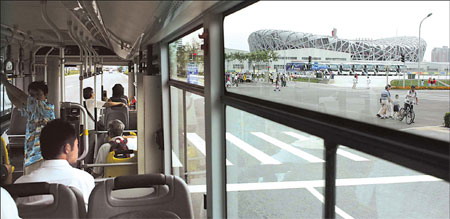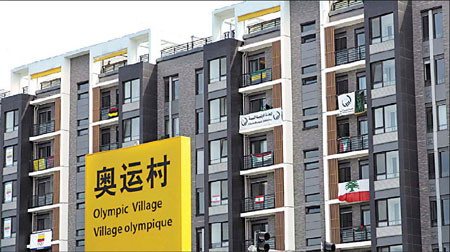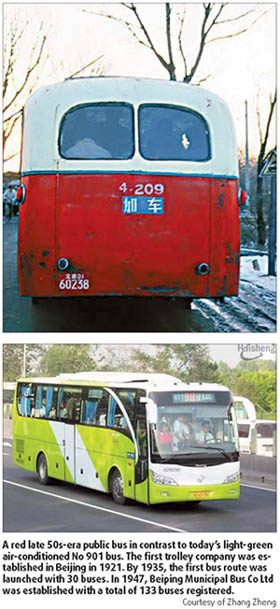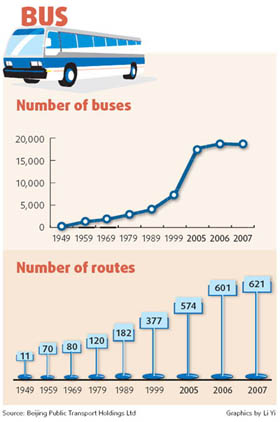Xie Deming does not have a ticket to any event of the 2008 Olympic Games, but he has found his own way of joining in the Olympic fervor in Beijing. And it costs him just 1 yuan (15 cents).
Like thousands of ticket holders, the 31-year-old migrant worker from Hubei province is making good use of the special Olympic bus routes available to take spectators to the sports venues.
The only difference is that Xie takes the bus to sightsee such Olympic architectural wonders as the Bird's Nest stadium and the Water Cube.

Among the sights seen by riders on special Olympics Bus No 1 is the Bird's Nest and cauldron. [China Daily] |
"During the Games, more than 14 million people take the bus as their first choice. Buses today are truly the people's transport," Director Liu Runfang of Beijing Public Transport Holdings Ltd said.
The addition of special bus routes during the Olympics is the latest expansion of this form of public transportation as Beijing tries to keep pace with the increasing demands of rapid urbanization and population growth in the last two decades. The city is encouraging more residents to take the bus with low fares, good facilities and routes with wide coverage.
Last Friday evening, Xie was standing in a line of people waiting for Bus No 1 at the Olympic South Station near Beitucheng East Road. Bus No 1 is popular as it has the giant steel Bird's Nest stadium and futuristic Water Cube on its route. People with tickets for Olympic events, members of media covering the Games and Olympic volunteers can all take the bus for free.
For people like Xie, 1 yuan will provide a nice visual tour of these Olympic venues through the bus window.
"It is a good way to see these Olympic venues," he said. "Otherwise, I can only see them on TV. So I guess this is a good chance to see the real thing up close."

The Olympic Village where athletes display their countries' national flags from the balconies and windows. [China Daily] |
Xie was not alone in the long line this evening. College student Luo Hengzhi and his girlfriend Xu Qing were doing the same thing. "We don't have (Olympic) tickets, but we think it is a good idea to see the blue Water Cube and Bird's Nest illuminated at night," Luo said.
There are other Beijing residents who benefit from the special Olympic bus routes in their own way.
Sun Xiaojing, 27, a contractor at the logistics department at the Olympic village, said that instead of making two changes on the subway, she is taking the bus directly from her home near the Qianmen Street to the village.
"Why not (take the bus)? It is convenient, quick, and cheaper," she said.
Even without the advent of the Beijing Olympics, more than 12 million people take buses every day in Beijing. This public transportation system covers 18 districts and operates 633 routes.
"Beijing is a huge metropolis which means the traffic patterns are complicated for public transportation, so it is very important to arrange the bus routes scientifically," said Zhang Zheng, a 27-year-old conductor of Bus No 27 said.
Zhang has been crazy about buses ever since he was 6 years-old and can tell you where every bus stop is in the city. In July, he published a Beijing Public Transportation Guide which lists more than 5, 000 bus stops in alphabetic order.
"Many bus stops just move away without notice, which causes a lot of inconvenience to passengers. I often go out to check the bus routes and correct the mistakes." Zhang explained.

Those inconveniences pale in comparison to the dramatic changes that 75-year-old retired post office accountant Li Peixin has witnessed in his five decades of riding the public bus.
"I have lived in the Fengtai district since 1960. Back then, there was only one bus route connecting the Fengtai district to downtown Beijing, which was far from the residential area," Li recalled. "And the bus never showed up on time," he added.
A trip downtown meant a half -hour walk to the bus stop, at least a half-hour wait, and a more than two hour long ride for Li.
"People just had to wait for that shabby bus for a long time, freezing in winter or sweating in summer," he said.
Today it is less than five minutes' walk for Li down to Xiluoyuan Road where several buses pull up to bus stops. This is where Li has taken the bus every morning ever since he retired in 1995, and he has more than one option.
"It's really convenient. In less than an hour I can reach the Temple of Heaven for my morning exercises," Li said.
It's also cheaper. In the old days, the bus fare started at 4 or 5 fen for the first three stops. Given the low wages, 5 fen was the price of a pancake. Today, everyone can enjoy a ride by bus to anywhere in Beijing at the lowest fare in China. On January 1, the fare on a bus pass was dropped to 40 fen for adults and 20 fen for students.
"Due to the fare adjustment, I can save about 50 yuan a month, which is about half of my original transportation fee," Li said.
The reduction in bus fare is an effective way to encourage people to take public transportation, which helps alleviate traffic congestion, Beijing Public Transport's Liu said.
"In 2005, about 28 percent of residents took the bus," Liu said, "while today more than 34 percent take the bus as their first choice."
Wu Jialu, a white-collar worker, is certainly one. "I will take the bus as my first choice because we enjoy the lowest bus fares in the world, in my opinion," he said.
Deputy Director Zhou Zhengyu of the Beijing Municipal Committee for Communications said Wednesday that the current low bus fares are not just for the duration of the Games but will remain in place for a considerable amount of time afterwards.
"We have successfully brought public transportation into (all) communities as of 2005," Zhou said.

According to Liu of Beijing Public Transport, 131 new bus routes have been added since 2006, 65 of which connects more than 500 communities, including Tiantongyuan, Huilongguan and Fengtai district, to downtown Beijing.
There are eight special Olympic bus routes, which operate between 6 am to 10 pm every day, and 26 express buses, which operate three hours before and one hour after each event at certain venues.
Each venue has at least one special bus that stops directly at the security doors of each venue.
For some important venues like the Bird's Nest, there are seven special routes and seven express buses. People who want to check where to take these special buses can check the following link: http://jtcx.beijing.cn/fuwu/aygjzx/